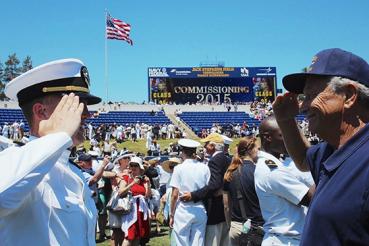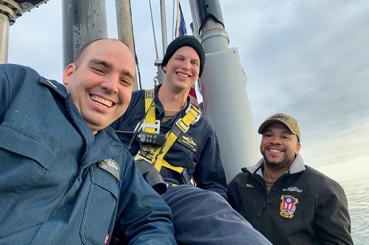How a Navy Veteran Applies a Submarine Mindset to Public Health Problems
In recognition of Veterans Day, AIR’s Andrew Blank, a U.S. Navy veteran, discusses his military service, his transition to public health, and his commitment to veteran's issues.
Running the Endurance Course as a Plebe Summer squad leader in India Company, 17th Platoon. U.S. Naval Academy, 2014. Andrew is in the black shirt.
Andrew Blank, a 7-year Navy veteran, joined AIR in 2022. At AIR, Blank serves as project director for a National Defense Education Program-funded civics education project and online module development manager and visiting trainer for the Integrated Prevention Technical Assistance Center. He also provides research and project management support to the U.S. Department of Education's Region 9 Comprehensive Center.
In addition, Blank serves as project manager for a grant working to improve care for non-English speaking patients who are hospitalized at the University of North Carolina Medical Center. This project recently earned top finalist recognition for the Joint Commission’s 2023 Bernard J. Tyson National Award for Excellence in Pursuit of Healthcare Equity.
Blank is a member of the AIR Stars and Stripes Employee Resource Group.
Q. How did you choose your Navy career path and what roles did you serve in?
Blank: As a high school sophomore, the Naval Academy catapulted to the top of my college list after I had the opportunity to eat lunch in the dining hall and appreciate that squad’s camaraderie and purpose.
I entered as a plebe (freshman) in 2010, majoring in chemistry and minoring in Arabic. During a visit onboard USS Wyoming, a junior mechanic taught me about submarine atmosphere control systems (we make our own oxygen and drinking water!). I chose submarines because of his passion.

I commissioned as an Ensign in 2015. It is tradition for new officers to receive their first salute from someone of personal significance in exchange for a silver dollar; I received my first salute from my grandpa, who is a veteran submariner. (See photo, right.)
After 18 months learning naval nuclear propulsion systems and tactics, I reported to USS Ohio in December 2016 for my “sea tour.” As a division officer on Ohio, I held a range of jobs, including leading nuclear mechanics, torpedomen, and sonar technicians. While Officer of the Deck at sea, I led the navigation and weapons teams.
While Ohio was in the shipyard, I deployed with USS Topeka to the Western Pacific. We missed the 2018 Winter Olympics but made up for it with port calls in Japan. That mission—and the privilege of being on that team—was the highlight of my naval career.
From 2019-2021, I spent my “shore tour” at Naval Surface and Mine Warfighting Development Center, a schoolhouse in San Diego, California, where I developed and delivered curriculum building capacity of Surface Warfare Officers to track enemy submarines.
My proudest moments are earning my gold dolphins (submarine warfare insignia), accomplishing our mission on Topeka, getting Ohio back to sea, and watching my sailors grow as leaders.
Q. How did you transition from submarines to public health?
Blank: My medical school dreams died in organic chemistry, but I’ve always valued health as a human right, and by pure serendipity found the University of Southern California’s Master of Public Health program.
During the program, I had the privilege to intern at the Refugee Health Unit of the University of California, San Diego Center for Community Health, where my work initially focused on evaluating mental health programs for refugee youth, then shifted to building a community health worker program through the San Diego Refugee Communities Coalition in response to the pandemic.
My first civilian job was with a large healthcare system, where I was a project manager for about six months. Fifty-seven percent of veterans leave their first civilian jobs within the first year. I was thrilled to transition to AIR in April 2022.
Q. How does your military service impact your work at AIR?
Blank: Submariners train to think in systems. I led a team of experts in sonar, navigation, radio, weapons, ship control, and nuclear power. My job was to understand what they and their systems brought to the team and what they needed, then to integrate those assets and needs to achieve safety, stealth, and mission.

The same systems thinking is helpful in public health—for example, in our comprehensive approach to violence prevention work, recognizing how a mix of activities (e.g., policies, programs, and practices) at the outer levels of the social-ecological model can foster environmental conditions that reduce violence.
Submariners also practice operational planning. To deploy successfully, we planned for and responded to external inspections, severe weather, personnel changes, and thousands of nautical miles. To implement a quality project, our operational plan must be similarly flexible so we can respond to environmental changes—for example, last year a client published the governing instruction for a process after our team had already spent months developing curriculum about that process.
Photo, above: USS Ohio (SSGN-726) (Blue) en route to Southeast Alaska Acoustic Measurement Facility (SEAFAC), Ketchikan, Alaska, 2019. Left to right: Fire Control Technician Senior Chief Petty Officer (FTCS) Craig Allen, Lieutenant Andrew Blank, Torpedoman’s Mate Chief Petty Officer (TMC) Ventavious Bell.
Q. What should the public know about the veteran population and related public health issues?
Blank: In 2022, there were 18.4 million U.S. veterans, representing about 7% of the civilian noninstitutional adult population. That includes 4.9 million veterans who served post-9/11.
We’re seeing some progress in a few areas. For example, there were 33,000 veterans experiencing homelessness in the U.S. in 2022—down 55% since 2010, reflecting positively on the Biden Administration’s “housing first” approach. At the same time, there are many serious issues facing veterans. In September 2023, the unemployment rate for veterans climbed to 5.3% for ages 25-34 and 6.6% for ages 35-44, much higher than 3.7% and 2.5% for non-veterans. In 2020, there were 6,146 veteran suicide deaths, and suicide was the second leading cause of death among veterans under age 45. Each year from 2001 through 2020, age- and sex-adjusted suicide rates of veterans exceeded those of non-veteran U.S. adults (e.g., 57.3% higher in 2020) (2022 National Veteran Suicide Prevention Annual Report).
Q. How can AIR and other employers support veterans?
Blank: I can’t speak for all veterans, but if you’re looking to thank us for our service, providing community and purpose are a great start. We value team and mission. I’m grateful to work with AIR colleagues who care about each other and give me opportunities to grow and meaningfully contribute to important work.